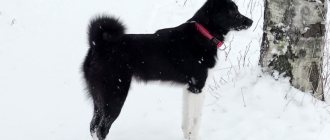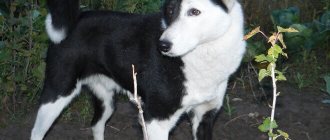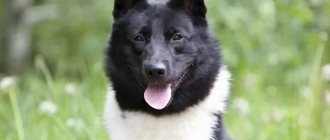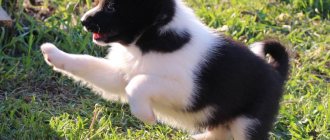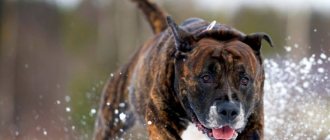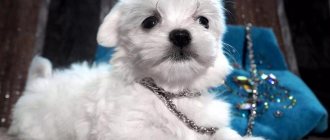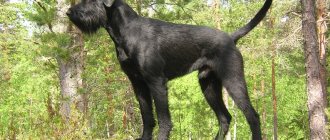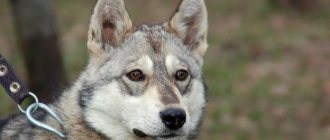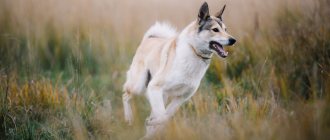Hunting with a husky is a dynamic, amazing action in the wild. This is a universal activity for an experienced hunter and his equally experienced tailed companion. When hunting with a husky, the hunter allows himself to choose almost any type of game, starting from small birds or hare and ending with a large and dangerous bear, wild boar or elk.
The genetic skills of the dog breed perfectly contribute to high-quality and productive hunting of animals, but at the same time there are enough difficulties in such an activity and a lot of work in training and preparation. Hunting with a husky is not suitable for novice hunters due to the danger of it being carried out by an inexperienced, unprepared game hunter.
Basic moments
- The owners of Russian-European Laikas changed the breed abbreviation “to suit themselves”, calling their charges simply relks.
- This is one of the few varieties of huskies whose representatives can actually be kept in a city apartment.
- There are several breeding lines of the breed in Russia, each of which has its own specific characteristics both in terms of appearance and performance indicators.
- All RELs are very attached to a person and are capable of getting bored even in cases where they will be separated from only one of the family members. Therefore, complete loneliness, even short-term, breaks the animal’s psyche.
- The breed has a heightened hunting instinct, so it is easily trained on any animal, including all types of game.
- Laikas that hunt regularly are indifferent to livestock and poultry, so you don’t have to worry about the lives of the inhabitants of the peasant farmstead. The exception is teenage puppies, who love to practice working techniques on all representatives of the fauna.
- You shouldn't buy a reel if you don't plan to go hunting with it. Walks in the park and sports will not satisfy the breed's need for movement.
- REL's main competitor is the West Siberian Laika, which modern hunters consider a more prey and unpretentious breed.
The Russian-European Laika is a sociable and versatile hunter who loves children and willingly devotes all her free time to playing with them. Possessing an outstanding sense of smell and keen hearing, relks will become indispensable assistants in cases where hunting turns from a hobby into a passion. At the same time, the breed does not require much for itself and easily adapts to the most modest living conditions, preferring constant interaction with a person, or better yet, with a large family, to everyday comfort.
Elk
According to the advice of hunters, training a husky to hunt an elk should be done when the dog has already mastered bear hunting. In this case there will be no problems. The main qualities that a dog must have are the ability to dodge the beast and move quickly.
Now we will tell you how to train a husky to ride a moose. It is better to start in the fall or early spring, when there is no snow on the ground yet, but it is already quite cool. Ideally, go to the mountains, because then it will be easy for a husky to run on frozen ground, but a moose, like any ungulate animal, will not be able to run away quickly.
For the first time, it is recommended to choose a weaker object. At this age, the dog must be quite mature, because it will have to not only pick up the scent of the prey, but also chase it, which will require significant physical effort. The hunt itself consists of the dog tracking the animal and then starting to chase it. As a rule, the chase ends with the artiodactyl itself coming out to the hunter, who shoots him. The very first prey in your husky’s life must be killed, and the pet must be praised by feeding it well.
In another option, the dog must drive the prey to the so-called “slop”, that is, a place from where the elk can no longer escape. For example, it could be a rock ledge. The hunter then approaches and calmly kills the prey. Using a similar technology, huskies are sent to hunt mountain sheep, deer and other ungulates.
Moose training begins when the husky turns two years old. It is best to send a young husky hunting with an experienced dog. Be prepared for the fact that not all huskies have the natural talent for tracking elk, and not all have the necessary qualities. The very first lessons will help you answer the question of whether this particular pet is worth training for a moose or abandoning this idea. If you are not sure whether your husky behaves correctly upon first contact with a moose, record everything on video and show it to experienced professionals. They will be able to give an objective assessment of your dog’s capabilities and advise which animals are best to go with it to hunt.
Breed characteristics
- Aggressiveness: Moderate ( Overall score
3/5) - Activity: Very high ( Overall score
5/5) - Training: Easy ( Overall score
4/5) - Shedding: High ( Overall score
4/5) - Need for care: Medium ( Overall score
3/5) - Friendliness: Very friendly ( Overall
5/5) - Health: Good ( Overall score
4/5) - Cost of maintenance: Above average ( Overall score
4/5) - Attitude towards loneliness: Short periods ( Total score
2/5) - Intelligence: Standard ( Total score
3/5) - Noise: High ( Overall
5/5) - Security qualities: Good ( Overall score
4/5)
Story
The Russian-European Laika, as an independent breed, was created according to plan. In 1949, Soviet breeders decided to give hunters another type of hunting dog, using the gene pool of the Karelian, Arkhangelsk, and Komi Laika as a basis. However, the most difficult thing for specialists turned out to be not to cross individuals from the listed offspring (such matings have long been practiced by amateurs), but to bring the resulting offspring to a single type. As an example: by the middle of the 20th century in the USSR there were about ten varieties of Russian-European huskies that had a very distant resemblance to each other.
One of the very first and most prolific participants in the experiment is a dog named Tuzik, who belonged to the breeder Sh. A. Isaev. This native of the Komi Laika helped the birth of dozens of Russian-European Laika puppies, essentially becoming the official great-grandfather of the breed. As for the formation of a single exterior, it only happened in 1964, although work on individual lines of the breed continued until perestroika times. It is known, for example, that the most popular branches of Russian-European huskies originated from the male dogs Putik, Bublik and Sharik, and their representatives received from their ancestors excellent external characteristics and developed hunting instincts.
Since the early 70s, new breed groups of Russian-European Laikas began to appear. These are the Jack and Joy lines known to all modern breeders. Unfortunately, already in 1979, breeding hunting huskies lost its popularity, which was greatly facilitated by the state ban on shooting squirrels. And although by this time the breed had made a good exhibition career, and a year later even received FCI registration, this fact had a negative impact on its development. Today, you can meet the Russian-European Laika hunting less often than its relatives, the Westerners. Nevertheless, these versatile fishermen still have fans, which helped them not to disappear and also maintain their performance characteristics.
Video: Russian-European Laika
Russian-European Laika standard
Russian-European Laikas have a very memorable appearance, which is partly due to the meager palette of colors. The dimensions of the representatives of the breed are average, the muscles are dry, and the dogs do not look thin-boned. The height of an adult male Russian-European husky is 52-58 cm; females - 48-54 cm. In general, “girls” have a more elongated silhouette (extension index in the range of 100-105), since this constitutional feature is necessary for bearing offspring. In other respects, males look brighter and more respectable than females, although they do not show significant advantages in work.
Head
Wedge-shaped outlines are typical for the heads of all Russian-European huskies. Between the dry, sharp muzzle and the skull there is a noticeable stop, which seems very sharp due to the convex brow ridges. The muzzle itself is shorter than the skull, while its upper line is parallel to the line of the forehead. The back of the head is rounded, with an easily palpable tubercle and parietal crest.
Lips, teeth and jaws
Elastic lips, tightly pressed to the jaws, do not form saggy jaws. The teeth are massive, even, closely spaced in a row. The only appropriate type of bite is a scissors bite.
Eyes
The Russian-European Laika has dark brown small eyes, which are characterized by a slightly slanted eyelid.
Ears
The shape of the ear is triangular, while the base of the hearing organ is wide and the tip is sharp. The ear position is erect. The ear flap is small in size and very mobile.
Neck
Optimal proportions are when the length of the animal’s neck and head are the same. To the touch, the neck is very muscular, dry in outline, set in relation to the body at an angle of 45 to 50 °.
Frame
Russian-European huskies are dogs of moderately strong build with a wide chest reaching down to the elbows and a straight, but not long, back. The animal's loin is convex, with a developed muscle corset. Belly with a clearly defined transition from the sternum to the abdominal area. The cereal zone is quite short, with a slight slope.
Limbs
REL's legs are dry, with well-pumped muscles, located parallel to each other when looking at the animal from the front. The shoulders are moderately oblique, the elbows are large, directed backwards. The pasterns are medium in size and have a slight slope.
The hind legs are formed by long shins and almost vertical metatarsals. The breed's paws have the shape of a regular oval, thanks to the toes compressed into a ball. Dewclaws are not welcome.
Tail
Crescent or ring shaped, curved towards the back and pressed against the dog's outer thigh. When unfolded, the tail reaches the tarsal (hock) joint or is located at a distance of 1-2 cm from it.
Wool
The coat of the Russian-European Laika is a hard, straight coat and a thick undercoat layer. The dense hair covering the dog's head and ears is very short. The shoulders and neck are “dressed” in a rich spine, forming an expressive “collar”, and behind the cheekbones are stylish “sideburns”. Males have longer hair on the withers. The hair on the legs is short, close-lying, slightly lengthening only on the back of the limbs. There are neat feathers on the hind legs. Between the toes, the fur grows like a thick brush, while the paws are covered with short and smooth hairs. The tail is without dewlap, but with an elongated straight spine on the lower part.
Color
Russian-European huskies are born black and piebald, completely white, and also with a solid black color.
Breed defects
Serious defects in the exterior, for which the exhibition score is reduced, are called defects. For Russian-European Laikas these include:
- deviation from the height recorded by the standard by more than 2 cm;
- specks on the body, as well as specks that do not match the main color on the legs and head;
- the coat is loose, wavy or curly;
- long head, massive muzzle without stop;
- hanging or semi-erect ears;
- discord;
- hunchback and barrel chest;
- clubfoot or with splayed legs;
- straight or saber tail.
Dossier
Adult dog height: 54 cm. Weight: 18-23 kg. Characteristic color: black and white. Coat length: medium. Life expectancy: up to 12 years. Advantages of the breed: excellent hunter for any type of game, intelligent, friendly. Difficulties of the breed: likes to make decisions independently, not intended for a quiet, apartment life. Average price: $300. Classification : medium, hunting.
Character of the Russian-European Laika
The Russian-European Laika is a dog in love with its owner, and at the same time with all his associates, from family members to friends. Representatives of this family, in principle, are not prone to aggression towards humans, and when it comes to children, huskies immediately turn into the most good-natured and forgiving creatures in the Universe. The breed's territorial instinct is very moderately developed, so its representatives make mediocre watchmen. However, some breeders specifically cultivate protective qualities in their charges. Such individuals are noticeably more suspicious than their relatives and are no longer so loyal to strangers. Therefore, if you need a dog that can be involved not only in hunting, but also in a simplified version of the ZKS (protective guard service), look for a seller who specializes in breeding guard huskies.
The main weapon in the fight against suspicious guests, available in the arsenal of every Russian-European husky, is a loud bark. By the way, about the “vocal abilities” of the breed: REL are happy to raise their voice with or without reason, and especially piercing concerts are staged by bored individuals. Accordingly, if you keep a Russian-European Laika in your apartment and are often away on business, get ready to ruin your relationship with your neighbors, who are forced to be unwitting listeners to your pet’s musical exercises.
The patience of Russian-European huskies has become something of a legend, so a properly trained dog will always allow its owner to pull a bowl of food out from under its nose and will suppress any counter-protest. At the same time, REL react very sharply to unfair punishments. Therefore, before you slap your dog on the nose with a newspaper, think carefully about whether the pet deserves such treatment. Also consider the exercise needs of the breed. If the Russian-European Laika does not go hunting for a long time and at the same time lives in the house, destruction of the interior is inevitable. And the point here is not in the obstinate nature of the relics, but in natural instincts that do not find application in everyday life.
Hunting with Russian-European Laika
Russian-European huskies are universal hunters, in Russian realities they work excellently on both game and any animal. In addition to its sense of smell, the breed uses sight and hearing in its search, which makes hunting with reels as productive as possible. In addition, Russian-European Laikas are distinguished by the breadth and speed of their search, which helps them successfully compete with Westerners. A very important nuance: different techniques for working with game and animals, found in representatives of different breed lines. Typically, most relics work with their lower senses, following the scent directly, and only occasionally using their auditory receptors.
Some huskies belong to the high-sniffing type, that is, they are guided by the smell coming from the ground and distributed by the lower layers of air. Moreover, under different conditions, the dog can change its reconnaissance technique, moving from the upper to the lower scent and back. A separate category of REL are those who hunt by hearing. The sensitivity of such individuals is slightly less developed, therefore, in the process of pursuing prey, the animal often stops, then runs towards the sound and only barks at the prey in the end. In all respects, the so-called spirit huskies, which have equally developed sense of smell and hearing, are considered ideal hunters, but there are much fewer such individuals and they are more difficult to find.
Some experts recommend specially training your pet's hearing, starting from puppyhood. The Laika is taught to listen to the whisper of its owner, to pay attention to the sounds of wildlife (the cries of birds, the knocking of a woodpecker on a tree, etc.). However, such exercises do not always give the desired result, since individuals with a dominant sense of smell will still prefer to rely on their nose rather than their own ears.
Start date
Training a husky on a marten should begin quite early - from 9 or 10 months of age. Initial training should be of a general nature, including the education and development of basic hunting skills. At the same time, it is very important to establish contact with the dog, teach it obedience and follow basic commands. At the same time, the husky is trained to wear a collar and leash.
As soon as the dog has more or less mastered the basic training program, it should begin to be taken out into the forest. The first few walks should be of an introductory nature to allow the husky to get used to the terrain. At the same time, the dog must not be allowed to lose visible contact with the owner. To do this, it is necessary to choose more open areas with sparse tree cover (edges, clearings, etc.). It is not recommended to go deep into the forest.
As soon as the dog matures and becomes more confident both in navigating the terrain and in working with the owner on the basic course, you can begin specialized training for fur-bearing animals.
Education, training, grooming
The training of the Russian-European husky is based on helping the animal become a professional getter of forest and field trophies. The remaining service commands are discarded. At the same time, you can take a UGS course with a pet living in urban realities. True, according to experienced hunters, such “education” does not have the best effect on the instincts of the breed; as a result, dogs trained in service commands perform much worse.
You can groom your future hunting husky from as early as three months, regardless of the time of year. Start with short walks in the forest and try not to make noise so that the puppy can listen to new sounds. The grooming technique also depends on what type of animal and game is to be hunted. For example, to work with waterfowl, you need to teach your puppy to overcome his fear of bodies of water. It is better to hunt the Russian-European husky hazel grouse in the fall and in those forests where young feathered animals definitely live.
Important! Russian-European Laikas, who live in city apartments for years and go hunting only once a season, may lose their keen sense of smell. Usually the sense of smell is restored during work, but this does not happen immediately.
Mandatory skills for hunting huskies: walking next to the owner, willingness to sit down and give an object on command, including from the water. Breeders recommend organizing the training process with the help of additional equipment: a 20-meter leash with a carabiner, a plain whistle, a carrier (a piece of wood or a soft fabric toy). It is acceptable to use a thin rod when practicing the “No!” command. Traditional scheme: a dog caught picking up food from the ground is held at the “crime scene” and whipped sharply, but not too hard, with a vine. If you don’t have a rod at hand, it’s useful to pull the leash and voice the command. At the same time, it is strictly forbidden to hit a Russian-European husky with your hand or leash.
By the age of six months, a Russian-European Laika puppy is usually socialized: he knows his name and responds to it, is accustomed to walking on a leash, and has fit into the hierarchical system of the family in which he lives. Therefore, at 6 months the animal can be prepared for hunting and trained. The first command to learn is “Near!” The owner takes the Russian-European husky outside, gives an order, patting himself on the thigh and at the same time pulling the puppy towards him by the leash. The strap is then gently released and the pet receives a rewarding pat or treat. By the way, for the latter it is better to buy a belt bag. Over time, the husky will understand where the owner hides the treats and will try to earn them.
After the Russian-European husky has learned to walk side by side, start practicing the “Sit!” command. Everything is traditional here: after the order, the pet is gently pressed on the sacrum, forcing it to sit down on its hind legs. At the same time, the puppy is taught to give diarrhea correctly. The scheme is simple: shake a cloth stuffed animal in front of the animal’s nose. When the pet begins to grab the object with its teeth, throw it forward with the command “Give!”, and after the husky picks up the stuffed animal, gently take it away, rewarding the puppy with a treat.
If you plan to go waterfowling, teach your Russian-European Laika to swim. Only without extremes: throwing a puppy into the water, as home-grown “pros” do, is a harmful and empty activity that will provoke hydrophobia in the animal and nothing else. It is better to start by crossing shallow reservoirs (the owner goes first, followed by the puppy) and only in the warm season, since dogs also need time to get used to and harden. As for baiting large animals, it can be done at stations and with animals at least 1 year old. And of course, take into account the individual characteristics of your own pet: some huskies are not vicious enough for such an activity and are often frightened by potential prey that is larger than them.
Capercaillie
Experienced hunters note that training a husky to hunt a capercaillie is no fundamentally different from trying to teach it to hunt other upland game - hazel grouse, black grouse.
Training should begin with the beginning of the summer-autumn season, when the bird has not yet matured and is kept mainly by broods. Most often, having risen to the wing, they cannot fly far, noisily perching on nearby trees. Kluha, with her loud cackling, can only provoke the dog.
Remember that wood grouse at this time are located in old clearings, surrounded by forest on all sides, as well as along forest streams, in remote places where people rarely visit, but there is a lot of gonobobel, blueberries and lingonberries. You need to arrive early to hunt the game, no later than six o’clock in the morning, when the dew has not yet dried, the husky can easily catch the trace of the bird. At this time, the fat deposits should still be clearly visible on the trampled grass; the dog will become interested in them and begin to try to figure them out.
Approaching the bird, the young husky slows down, begins to bend down and sneak up, and then makes a sharp jump. The bird flies up, lifting the entire brood with it. Having flown a short distance, wood grouse sit down in the trees. After the birds take off, the husky begins to chase the wood grouse closest to it. Running up to the tree on which he will settle down, she takes a comfortable position and wags her tail or bursts out into a ringing and loud bark.
At this moment, the hunter is recommended to approach the head of the barking dog as quietly as possible, so that the bird, interested in the barking, looks at it and does not notice you. From a distance of about 25 meters you need to fire a shot while barking. A successful hit is the key to successful training and subsequent hunting with this dog. Cut off the paw from the first capercaillie caught using a husky and give it as a treat, one finger at a time in three doses.
Maintenance and care
Despite the growing popularity of apartment keeping of Russian-European huskies, the ideal housing for the breed remains a spacious enclosure, facing the south with a lattice and equipped with a warm booth. The mandatory “walking minimum” for the Russian-European Laika is from 2 to 3 hours a day, and it does not matter where your pet lives - in an apartment or in the courtyard of a country cottage.
You should not be afraid of the destructive behavior of Russian-European huskies living in houses. If an animal is walked and hunted enough, it will not cause chaos. The exception is puppies, who taste the world around them, but a compromise can be found with them. Provide your puppy with plenty of toys and frequent treats of cartilage and flat bones to give your puppy something to occupy his teeth.
Hygiene
Methods of caring for apartment and enclosure huskies will vary. The former, as a rule, are poorer dressed, since they live in a warm place, therefore, during winter hunting, such individuals freeze faster. Residential Russian-European huskies shed throughout the year, so brushing your pet several times a week will save your home from hairballs. Enclosure dogs shed their coats seasonally, that is, twice a year, which significantly saves the owner’s energy. Theoretically, yard huskies need to be brushed only during the molting period, but in practice this has to be done much more often, especially if the animal often goes hunting, where it can pick up burrs.
Important! Russian-European Laika puppies should not be washed. Only adult dogs are allowed to bathe, and only in cases where it is really necessary.
The ears of Russian-European huskies are cleaned as they become dirty using hygienic drops and a piece of clean cloth. If there is a small amount of sulfur in the funnel, do not disturb your pet in vain: the husky is not a decorative dog that needs to be washed and combed endlessly. The breed's eyes are healthy, so special care is not required for them. Just brush away dust bunnies from the corners of your eyelids and clean your eyes once a week with chamomile infusion and a tissue.
Remove accumulated plaque from your dog's teeth weekly: you can do this with a toothbrush or a silicone brush on your finger. An alternative to classic cleaning is hard treats like sinew, as well as carrots and tomato juice. During the hunting season, special attention should be paid to the legs of the Russian-European husky. If, upon examination, scratches or cuts are found on the paws, treat the wound with an antiseptic. In winter, it is useful for urban huskies to treat their paw pads with protective creams that will protect their skin from toxic road reagents.
Feeding
Russian-European huskies are often fed animals they have hunted. The only caveat of this menu: a dog that eats hunting trophies will have to be treated for helminths more often. If you are not very lucky with working in the forest, your pet’s diet is based on any lean meat (from beef to poultry), raw tripe and offal. Once a week, meat can be replaced with fish fillet. To make dog dinners a little cheaper, they also add cereals – buckwheat and rice.
It is useful to dilute the meat component with seasonal fruits, young herbs, and vegetables. Russian-European huskies will not refuse sour milk, so get ready to periodically buy low-fat kefir, cottage cheese and fermented baked milk for your pet. To improve the appearance and thickness of the coat, it is recommended to treat your dog with a teaspoon of unrefined vegetable oil - it can be sunflower, olive or flaxseed oil.
Health and disease of the breed
In purebred huskies, there are practically no hereditary diseases, with the exception of hip dysplasia, the mechanism of which is not yet fully understood. At the same time, you will still have to monitor your pet’s health, given its active lifestyle. For example, REL are often injured while hunting and can contract various infections there. Therefore, treatment of the breed against ectoparasites, as well as with anthelmintic drugs during the hunting season, is mandatory. Sometimes Russian-European Laikas are diagnosed with epilepsy and urolithiasis. In addition, some individuals may develop food allergies, which can be easily combated through a properly formulated diet.
Precautionary measures
Catching a trophy in the form of a wild boar is a very dangerous activity. Safety precautions for hunting:
- have a first aid kit with you (for both the hunter and the dogs);
- do not approach a wounded animal without a weapon;
- do not shoot buckshot to avoid injury to huskies;
- know the rules of first aid;
- do not drink alcohol while hunting;
- Do not take only one inexperienced dog with you.
A good husky is an indispensable assistant in obtaining the desired trophies of large animals. And the process of hunting with dogs brings a lot of pleasure with its unpredictability and surges of adrenaline in the blood. For the hunt to be successful, you need to have remarkable courage and strength, which is why hunting is an activity only for real men.
How to choose a puppy
- Collect as much information as possible about the sires of the litter: presence of exhibition diplomas, pedigrees, exterior, tests for genetic dysplasia.
- Do not look for show puppies from breeders who breed purely working lines and vice versa. Hunting huskies will never have such a glamorous exterior as their show relatives, and show dogs are not as productive when hunting.
- Choose a female Russian-European husky if you are going to “work the fur” - when hunting squirrel and sable, “girls” are always more collected and prudent.
- For wild boar hunting, it is better to choose males - they are more passionate, angrier and an order of magnitude bolder than females.
- If the seller has not provided a litter inspection certificate, there is a high probability that there are mixed breeds in it, because of which the breeding commission refused to issue the documents to the breeder.
- Try to visit the kennel in advance so as not to pick up the last remaining puppy. Assess the entire litter: it is ideal if all the babies are approximately the same size.
- Maximum attention should be paid to the shape of the puppy’s head and bite, since it is these exterior indicators that determine the breed of Russian-European Laikas.
- It is not recommended to take the most dominant puppy in the litter: as he matures, such a REL will try to lead in the hunt and in everyday life.
- Test the hearing acuity and sensitivity of Russian-European Laika puppies before purchasing. Click your fingers over the kids' heads and see which one reacts first to the noise. The sense of smell is tested with a bowl of food placed at a distance from the animals. The puppy who smells the treats first will be the most instinctive in the litter.
- When buying an adult dog with a show diploma, pay attention to how it behaves in the ring. If the pet does not walk next to the owner and barks angrily at everyone, hunting with such a dominant will not be successful.
For marten
Hunting marten with husky is very effective. Having picked up the trail, the dog begins to work widely. Laika quickly overtakes the animal. A marten can climb a tree, or it can hide in a low, dry hollow or climb under a stump. A tree with a hollow is cut down, having previously plugged all the holes with dry branches or poles, and a blanket is thrown over the stump. The marten is forced out of the hollow with a stick into a dead end. The dog barks to show the person the location of the animal and remains on alert, ready to grab the marten that jumps out.
